Gear and Now: Amsterdam's Pedal-Driven Future
Amsterdam is a city powered by cycling. Ethel van Kesteren talks to Martin Sijmons, Amsterdam’s cycling infrastructure programme manager to take a look at how the city creating an exciting pedal-driven future.
Amsterdam and cycling have enjoyed a long-lasting love affair. Come rain or shine, good times or bad, Amsterdammers are out on their bicycles. The numbers back this up. With a modal share of 36% and 665,000 journeys daily, cycling is both the most popular and fastest growing way of getting around the city.
As a central part of Amsterdam (and Dutch) society, daily pedalling has become a solution to congestion, even across longer distances. The amount of and varied types of people doing it, the deep-rooted culture, and the way the city is geared towards it has led to Amsterdam becoming one of the world’s leading cycling cities. How has the Dutch capital reached this point? How is it ensuring that it remains fit for purpose for its favourite mode of transport? Martijn Simons, Programme Manager for Cycling Infrastructure, City of Amsterdam, shares his thoughts on these questions and the bicycle network of the future with Ethel van Kesteren.
What sets Amsterdam apart?
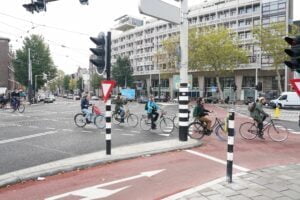
Cyclists crossing a junction
“Amsterdam’s cycling network is now so intrinsic to the city that we sometimes forget how unique it is to have infrastructure that enables quick, safe and comfortable cycling for all. We have foreign delegations visiting from all over the world to look at our network, and there are various reasons why they do so. We have a car-free green network and good connections within the region and more than 700km of separated cycle paths within the city. These really are only for cyclists. And there is so much more, such as numerous bike tunnels, how we design intersections and set traffic signalling to prioritise cyclists, and the dedicated cyclist waiting areas at traffic lights that offer a safe ‘traffic island’.
In many countries, much of this is still a long way away. However, that does not mean that we can rest on our laurels. We have a demanding cycling public that is growing and a world around us that is constantly changing.
Consider connections and plan, plan, plan
"In order to create a robust cycling network for now and the future, it is necessary to pinpoint the most logical ways to cycle through Amsterdam. Currently, doing what we want to do is a matter of negotiation. We often have streets that are less than 20m wide, and everything needs to be accommodated in this space: Walking, cycling, playing, trams, buses, cars, parking, trees and public bins.
In practice, it is a huge puzzle, and solving it requires close collaboration with various partners, such as government departments, NGOs and residents. For new parts of the city, it is crucial to consider how cycling fits into development plans as early as possible. If you only start thinking about routes once construction has begun, then you are too late. Indeed, adding good cycling facilities further down the line is difficult, like Bijlmer station where too little parking capacity was built. .
That is why I am happy that we are already considering cycling connections for future districts. Take the planned redevelopment of our former industrial harbour. This will transform into Port City, a new district for living and working. In its current location behind roads, railway tracks and allotments, it is quite isolated. However, we are already considering how we can connect this future district to the cycle network.”
Enticing everyone to get in the saddle
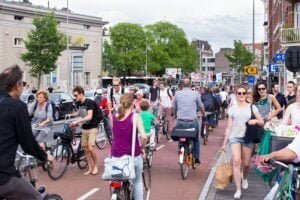
More room for pedestrians and cyclists, © Thomas Schlijper
"As the bicycle is our most important means of transport, we mainly focus on the important through cycle routes and the Plus Network, which comprises Amsterdam’s main cycle routes. The hustle and bustle in the city means it is vital to create more space and add new routes. In addition, we are working on green, car-free cycle routes, because they encourage less confident and assertive cyclists to get in the saddle. For example, I think of my 80-year-old mother who wants to cycle but not on a narrow bicycle lane, of small children, and of people for whom cycling is not necessarily their default mode of transport. For them, it is nice to learn how to cycle in an environment with few or no cars.
But how do you create safe, direct routes to residential areas that allow continuous cycling and convenient bicycle parking? In Amsterdam, linking in with the Autoluw – a policy programme aimed at generating more space for pedestrians and cyclists by reducing the presence of cars – has been crucial. This is helping create conditions that enable active mobility."
Consider the whole journey, including parking
"If you want people to cycle, the whole journey from A to B has to be good. That is why it is important to consider cycling infrastructure, parking and behaviour together - you cannot deal with them separately. For example, having only four places to park bikes at Isolatorweg - a terminus metro station - does not exactly invite people to cycle there. The same applies to residential areas. I enjoy living in Houthaven, a car-free neighbourhood in which children can play safely outside. Yet there is still work to do in terms of cycle friendliness. Residents can put their bikes in an underground shed, which requires going through two doors and down a ramp. This leads to both residents and visitors leaving their bikes on the street during the day, as there are no outdoor parking facilities.”
Looking towards the future
"Creating good cycling infrastructure is difficult. Indeed, there are still few examples of cities that are not oriented towards car use. Our best reference is actually the car-free Amsterdam of roughly one hundred years ago.
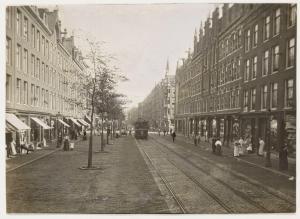
Kinkerstraat in Amsterdam in 1907, © Stadsarchief, City of Amsterdam
We also have many uncertainties to contend with in the future. What does the enormous diversity of bicycles, e-bikes, speed pedelecs, cargo bikes, and electric scooters mean for our network and parking? How can we anticipate what the impact might be of future scenarios like the advent of self-driving cars? In the short term, we are devising measures in response to the COVID-19 crisis; these focus on busy routes and intersections.
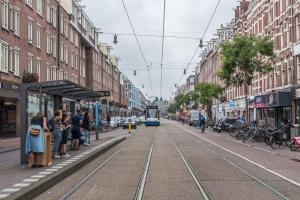
Kinkerstraat in Amsterdam now, © Stadsarchief, City of Amsterdam
It is therefore important when thinking about any (re)design that everyone is onboard. You cannot take that for granted, even in such a bike-friendly city. Our bicycle programme team invests much time and energy to build and maintain relations with the many stakeholders involved: from city planners and traffic designers to engineers and local interest groups. Ultimately, there is only one way to realise the future-proof bicycle network that we want for our city - together.”
What can other cities learn?
We can also learn from Handshake’s 10 “Future Cycling Capitals”. Although we are a known cycling city, there are some districts where nearly 60% of people cycle and others where less than 30% do. The difference is that in certain areas people simply grow up cycling less. How can we thus stimulate people to cycle who have never really done it before? All Handshake cities face this critical question.
Inspiring the next generation of cycling cities Amsterdam’s rich expertise and experience made it an ideal candidate to be a ”Cycling Capital” in CIVITAS Handshake. As part of this, Amsterdam is mentoring six European cities: Bordeaux (France), Bruges (Belgium), Dublin (Ireland), Rome and Turin (both Italy). In doing so, it is helping its mentees grow into real cycling champions. Here are Amsterdam’s top tips for aspiring “Cycling Capital”:
- Imagine - what would your city look like with less cars? More space for playing, greenery and simply living, as well as cleaner air…
- Reduce car traffic - there are no two ways about it. You can’t keep all the cars everywhere. Introduce one-way traffic in neighbourhoods. As a start, simple poles and signing to the main connecting roads could do. Lower the maximum speed to max 30 km/h or less.
- Charge for parking - In my neighbourhood, visitors pay €3.50 per hour. Expensive? In the city centre, it is €7.50! As resident, you also need a paid permit to park your car – valid only in your own neighbourhood.
- Build a safe, connected network - start with parallel routes through traffic-calmed neighbourhoods. On bigger roads, build separated cycle paths. Avoid isolated cycle links - connect places where people need to be. Start with popular destinations, such as cultural venues, shopping centres, and municipal buildings. Overall, it is crucial to link routes to people’s daily routines: school, work, food shopping. Last but not least, do not forget public transport hubs!
- Provide good and plentiful facilities – Put down red asphalt for smooth and safe cycling, have more green lights to keep cyclists moving, and have plenty of bike parking. Pamper your bike riders - they make your city!
- Involve others – you cannot do it on your own. Involve residents, shop owners, schools, advocacy groups, politicians, and children! Can you imagine them cycling to school all by themselves?
Author: Ethel van Kesteren is Senior Communications Advisor, City of Amsterdam. Additional input from Raoul Teekamp, Project Leader for CIVITAS Handshake, City of Amsterdam, raoul.teekamp@amsterdam.nl Compiled and collated by Richard Adams, Communications Officer, ICLEI Europerichard.adams@iclei.org
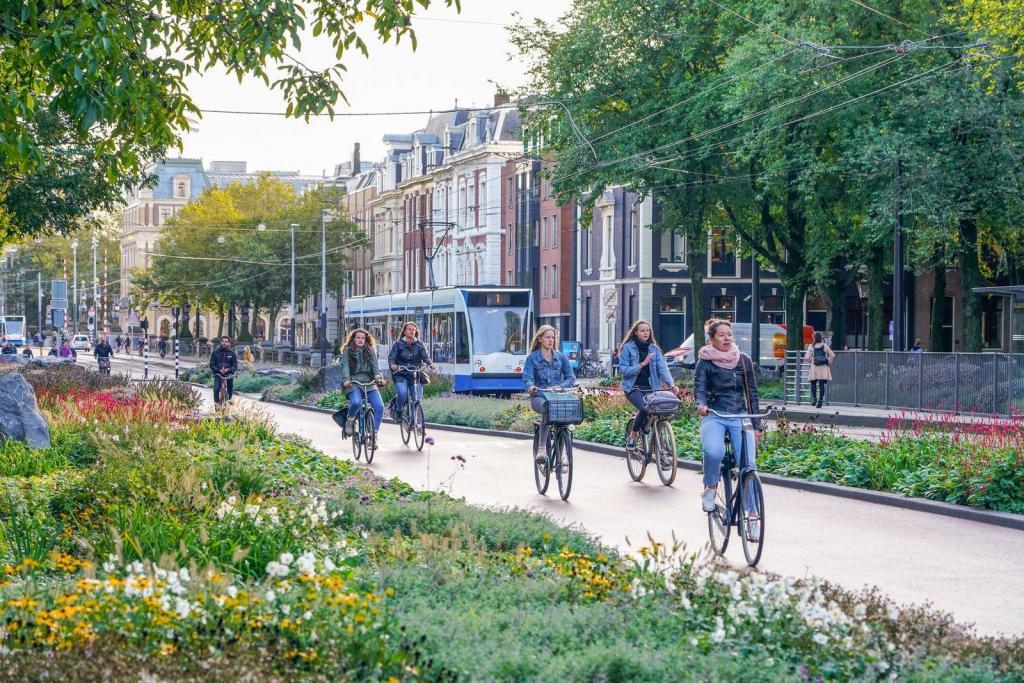 Sarphatistraat cycling ring road
Sarphatistraat cycling ring road